<HELI-EXPO
2006>
Current Situation of
HEMS in Japan

国際ヘリコプター協会(HAI)によるHeli-Expo2006は去る2月26日から28日までの3日間、米テキサス州ダラスで開催された。そのプログラムのひとつ、アジア・ロータークラフト・フォーラムで講演の機会を与えられたので、ドクターヘリの現状と将来について話をした。ドクターヘリは「3年で倍増」というのが話の主旨である。ここにその記録を残しておきたい。
なお、英文の作成にあたっては畏友山野豊氏のご教示をいただきました。厚く御礼申し上げます。
Below given is the text of a presentation that I delivered at the Asian Rotorcraft Forum in Heli-Expo 2006 held at Dallas Convention Center, Dallas, Texas on February 27, 2006.
In making the English text, I was helped by Mr. Y. Yamano, my valued friend to whom I express my sincere thanks.
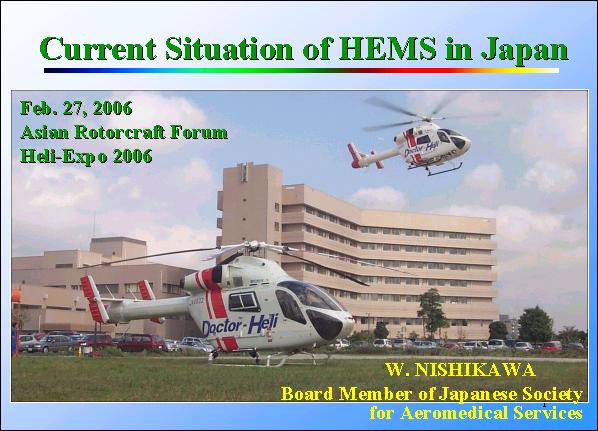
Thank you Mr. Nakayama and Mr.Matt Zuccaro, president of HAI, and thank all of you attending here. It is honor for me to make a speech now.
On the day before yesterday, when I arrived at DFW airport, I was asked by an immigration officer, "What is your visiting purpose to the United States?" I answered, "I am visiting here for attending the helicopter convention". But the officer could not understand my pronunciation, and again I said "helicopter". But still he cocked his head thoughtfully. Then I said, "It's a kind of aircraft". Finally he nodded with a smile and released me saying, "OK, go ahead."
This incident happened because I could not correctly pronounce "L", but I pronounced the sound of "R". In Japanese language, we have not the sound of L. So please understand when I say "herikopter" in my speech, it means a kind of vertical take-off and landing aircraft.
By the way, I would like to explain the "Current Situation of HEMS in Japan".
However, it is very pitiful for me to say that the Japanese HEMS operation started only 5 years ago, and is growing at a snail pace. It is 30 years behind the U.S., Germany, Switzerland and some of other European countries. They have started the HEMS around 1970.
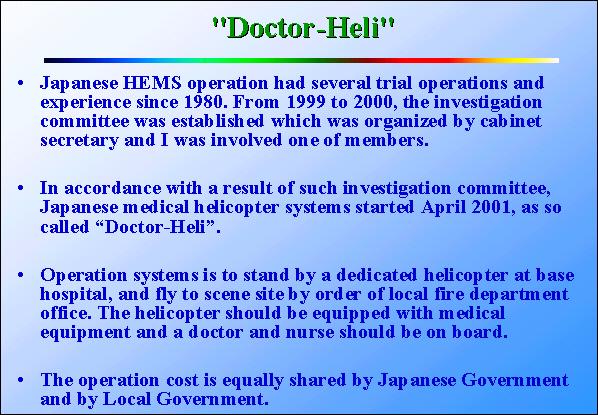
We call the Japanese Helicopter Emergency Medical System (HEMS) "Doctor-Heli". This is Japanese original naming, but it may be very understandable not only for Japanese but also for foreign people, too.
As you can see here Doctor-Heli started April 2001. Its operation system is almost same as yours that is a dedicated helicopter equipped with medical equipment stands by at a hospital, and in response to the emergency telephone call, the helicopter takes-off within 2 to 5 minutes with a doctor and flight nurse on board.
And operation cost is shared and borne equally by Japanese National Government and Local Government.
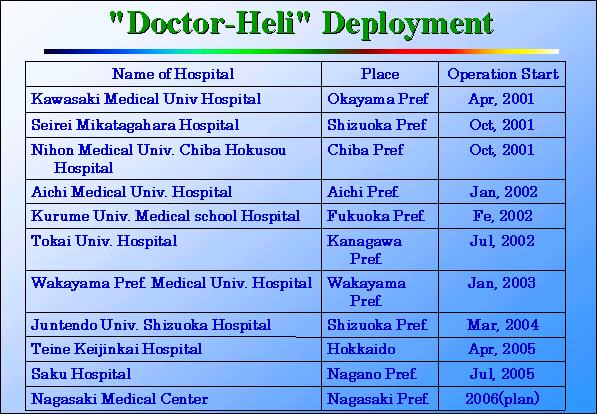
Currently in Japan, we have only 10 programs of helicopter EMS operation, as you see in this table.
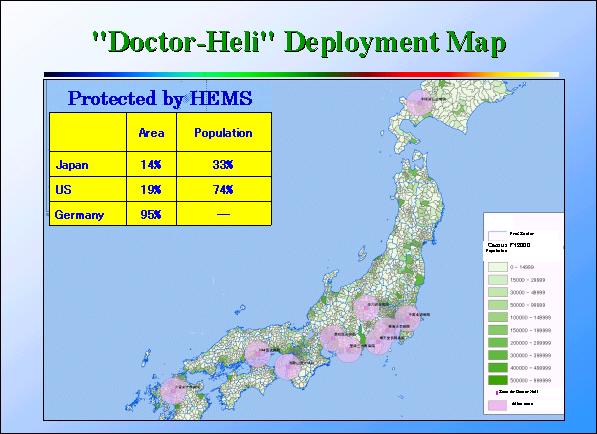
This is a map of Doctor-Heli standing-by location in Japan.
There are ten circles, each with a radius of 50 km, which means that medical treatment by a doctor at an emergency scene can be available within 15 minutes after getting emergency call.
10 circles cover about 14 percent of whole Japanese area. The number of residents of the area is about 33 percent of the total population of Japan. The 14 percent as well as the 33 percent are very small numbers compared with other HEMS advanced countries. For example, in Germany, more than 95 percent area is protected by ambulance helicopter's treatment circles of 50 km radius, and in the United State, even in such a big country, the covered area by helicopter's ten-minute flight circles is almost 19 percent and the percentage of the resident within helicopter territory is 74.

These are the results of Doctor-Heli operation carried out in 2004. At that time, we had 8 programs and they flew 1,554 hours and accomplished 3,445 missions. Therefore average flight hour per one mission was a 27-minutes, and mission number accomplished per one station was 430 missions.
These mission numbers are not so much, but in the near future mission frequency may increase.
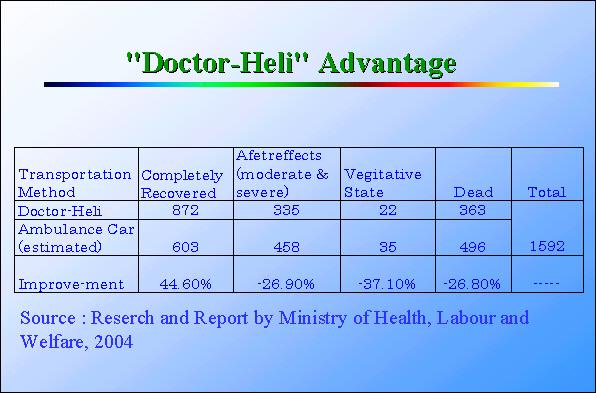
This shows the outcome of Doctor-Heli.
Number of patients treated at scene by a flight-doctor totaled 3,348 in 2004 as shown in the previous slide. Out of these patients, 1,592 patients could be traced through to the final outcome.
These figures are the actually traced cases, and the medical determinations are based on the estimations drawn from diagnosis, evaluation, or medical assessment by doctors.
So, for example, dead patients were actually 363, but if no helicopter were available and patients were transported by ground ambulance, 496 patients would have been dead. That means 133 lives were saved thanks to use of a helicopter. In other words, dead patients decreased by 26.8 percent for the sake of a helicopter utilization.
Again, actual number of completely recovered patients was 872. But if you did not use helicopter, recovered persons were only 603. That means persons who recovered and came back to social activities are estimated at more than 1.4 times of the cases that relied on ambulance.
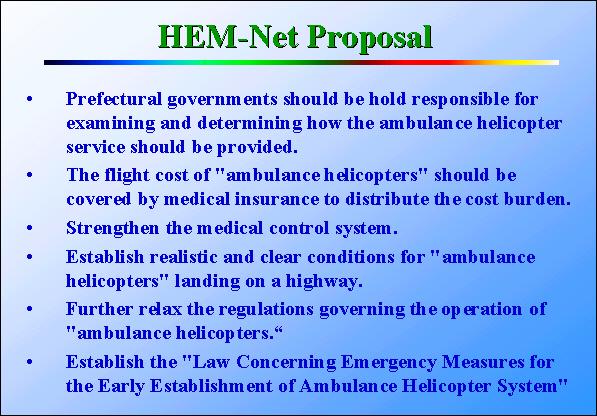
As we have seen, medical effectiveness in use of Doctor-Heli is very obvious. However, as I mentioned above, the current status of the helicopter ambulance system in Japan is very poor.
So the last year HEM-Net has raised several proposals as you see here to the Japanese government ministries and agencies, including all members of the national assembly, all the governors of Japan's 47 prefectures and others.
HEM-Net is a non-profit organization. The name of HEM-Net is an abbreviation of Helicopter and Hospital EMS Network, and I am a board member of this organization.
Among these proposals, I would like to explain the second item.
Presently, a half of the operation cost for HEMS is borne by the national government half and the remaining half by a local government. But in this system, each year its budget should be approved by the Diet. So, it is hard to keep stable management for HEMS operation or not easy to increase HEMS program rapidly.
Therefore we are proposing the current HEMS finance program should be changed, and the cost should be covered by insurance as seen generally in the U.S. and EC countries.
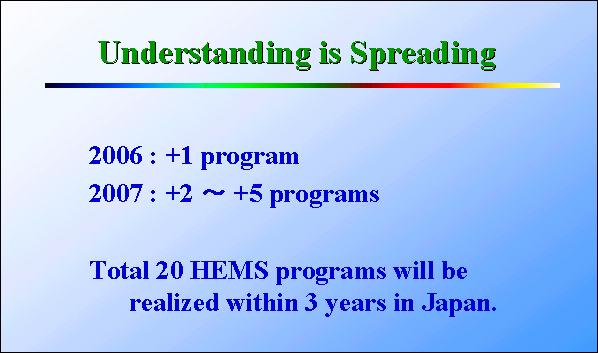
Recently the necessity of Doctor-Heli is gradually getteing better understanding among Japanese community, including members of the Diet and government organizations. Therefore, I really hope the above proposals may be realized, and the helicopter EMS operation will increase rapidly in Japan, accordingly.
This year we expect one program will be added to the current 10 programs. And the next year at least 2 and if much better, maximum 5 may be added.
So, we can expect the size of HEMS in Japan will be double in 3 years.
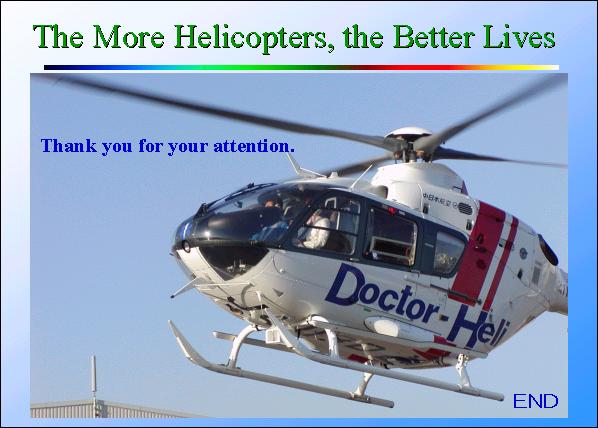
In conclusion, I would like to say "the more helicopters, the better lives."
Thank you very much for your attention.
(Wataru NISHIKAWA, 2006.3.6)
